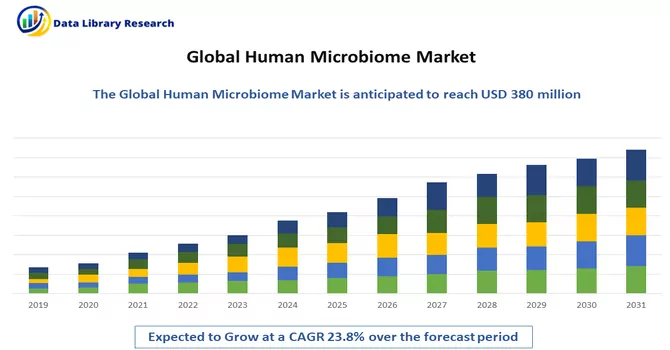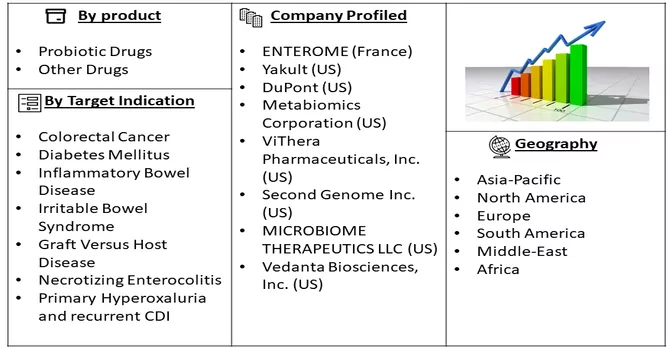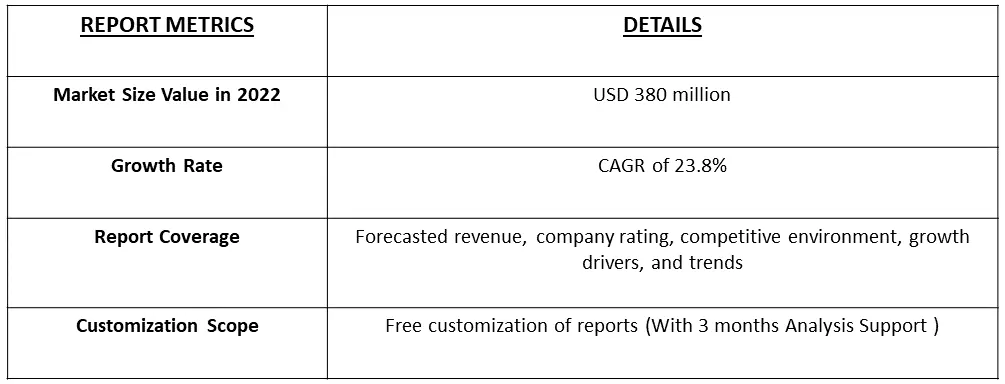The Human Microbiome is currently valued at USD 380 million in 2022, the human microbiome market is poised for substantial growth with a projected compound annual growth rate (CAGR) of 23.8% throughout the forecast period, 2023-2030.

Get Complete Analysis Of The Report - Download Free Sample PDF
The human microbiome refers to the collection of microorganisms, including bacteria, viruses, fungi, and other microbes, that inhabit various parts of the human body, both externally and internally. These microorganisms exist in and on the skin, in the mouth, respiratory tract, and particularly in the gastrointestinal (GI) tract, which harbors a significant and diverse microbial community.
The advances in sequencing methods and analytical techniques are driving progress in microbiome research. The integration of cutting-edge technologies enables more accurate and comprehensive analysis of microbiome data, facilitating the identification of novel insights and potential therapeutic targets. The identification of associations between dysbiosis and the development of various chronic conditions, including Clostridium difficile infections (CDIs), Crohn's disease, irritable bowel disease, ulcerative colitis, and diabetes, is a significant driver. This knowledge is spurring the development of microbiome-targeted therapies for specific medical indications. Thus, the above-mentioned factors are expected to witness significant growth over the forecast period.
The rising interest among researchers in human microbiomes, particularly their association with respiratory diseases and immunity, is driving increased investment in research and development activities. Advancements in sequencing methods and analytical techniques are contributing to a deeper understanding of the microbiome's role in health and disease. The concept of microbiome-based therapeutics is gaining traction within the medical science community. Ongoing research efforts are focused on developing targeted interventions and treatment options for a broad spectrum of medical conditions, leveraging the manipulation of the microbiome.
Market Segmentation: The Human Microbiome Market is segmented by Type of Product (Probiotic Drugs and Other Drugs), Target Indication (Colorectal Cancer, Diabetes Mellitus, Inflammatory Bowel Disease, Irritable Bowel Syndrome, Graft Versus Host Disease, Necrotizing Enterocolitis, Primary Hyperoxaluria and recurrent CDI), and geography (North America, Europe, Asia-Pacific, Middle East and Africa, and South America). The report offers the value (in USD million) for the above segments.

For Detailed Market Segmentation - Download Free Sample PDF
Market Drivers:
The Rise in the Prevalence of Diseases
The rise in the prevalence of diseases and the exploration of the human microbiome are two interconnected areas of research that have gained considerable attention in recent years. The human microbiome refers to the trillions of microorganisms, including bacteria, viruses, fungi, and other microbes, that inhabit various parts of the human body, such as the skin, gut, mouth, and other mucosal surfaces. These microorganisms play a crucial role in maintaining human health by contributing to digestion, nutrient absorption, and immune system function. However, disruptions in the balance of the human microbiome, a condition known as dysbiosis, have been linked to various health issues. Factors such as antibiotic use, dietary changes, and lifestyle modifications can influence the composition and diversity of the microbiome, potentially leading to an increased susceptibility to diseases. Thus, the the rise in the prevalence of diseases and the exploration of the human microbiome are intricately linked. Understanding the role of the microbiome in health and disease is opening new possibilities for therapeutic interventions and preventive strategies. As research in this field progresses, it holds the potential to revolutionize healthcare by providing more personalized and effective approaches to disease prevention and treatment. The above-mentioned factors are expected to drive the growth of the studied market.
Government Investments on Healthcare Infrastructure
Investments in both healthcare infrastructure and human microbiome research complement each other. A well-equipped healthcare system enables the integration of microbiome-based diagnostics and therapies into routine medical practices. Simultaneously, advancements in microbiome research contribute to a deeper understanding of the factors influencing health and disease, informing more effective healthcare strategies. Moreover, government funding plays a crucial role in supporting basic research focused on understanding the human microbiome. This includes studying the composition, function, and dynamics of microbial communities in different parts of the body and their impact on human health. Thus, the above-mentioned factors are expected to drive the growth of the studied market.
Market Restraints:
Lack Of Favourable Reimbursement Scenario And Technology Penetration In The Developing Economies
The global microbiome market, which encompasses research, diagnostics, and therapeutics related to the human microbiome, has witnessed significant advancements in recent years. However, the growth of this market is not uniform across all regions, with developing economies facing challenges related to reimbursement scenarios and technology penetration.
Moreover, the absence of well-established reimbursement policies for microbiome-related diagnostics and therapeutics hinders market growth. Without clear reimbursement pathways, healthcare providers may be hesitant to adopt these interventions, limiting patient access and the overall market potential. Thus, such factors are expected to slow down the growth of the studied market.
The human microbiome market has experienced limited impact from COVID-19, with researchers increasingly focusing on human microbiomes due to their association with various respiratory diseases and immune responses. However, the pandemic has disrupted many research and development activities, negatively affecting this market. The easing of restrictions is expected to benefit the market, as seen in the example of Seres Therapeutics, Inc. In July 2021, the company partnered with Nestlé Health Science to jointly commercialize SER-109 in the United States and Canada, aiming to pave the way for innovative treatment modalities.
Segmental Analysis:
Probiotic Drugs Segment is Expected to Witness Significant Growth Over the Forecast Period
Probiotic drugs and the human microbiome are closely intertwined subjects that have gained considerable attention in the fields of medicine and research. Probiotics are live microorganisms, primarily bacteria and yeast, which confer health benefits to the host when consumed in adequate amounts. The human microbiome, on the other hand, refers to the diverse community of microorganisms residing in various parts of the human body, such as the gut, skin, mouth, and other mucosal surfaces. Probiotics can influence the immune system by promoting a balanced immune response. They may enhance the activity of immune cells and modulate inflammation, contributing to the prevention or management of immune-related conditions. Thus, owing to such advantnges the segment is expected to witness significant growth over the forecast period.
Inflammatory Bowel Disease Segment is Expected to Witness Significant Growth Over the Forecast Period
Inflammatory Bowel Disease encompasses conditions such as Crohn's disease and ulcerative colitis, both of which involve chronic inflammation of the gastrointestinal tract. The human microbiome, which consists of trillions of microorganisms residing in the gut, plays a crucial role in maintaining intestinal health and modulating the immune system. The gut microbiome plays a crucial role in educating and regulating the mucosal immune system. In individuals with IBD, the immune system may react abnormally to the gut microbiota, leading to chronic inflammation. Moreover, probiotics, which are live microorganisms with potential health benefits, and microbiome-based therapies are being investigated as potential interventions for IBD. The goal is to restore a healthy microbial balance and modulate the immune response to alleviate inflammation. Thus, owing to such advantages, the segment is expected to witness significant growth over the forecast period.
North America Region is Expected to Witness Significant Growth Over the Forecast Period
North America, comprising the United States, Canada, and Mexico, has been at the forefront of research and advancements in the field of human microbiome studies. The exploration of the human microbiome in North America has contributed significantly to our understanding of its role in health and disease.
Furthermore, North America is home to some of the world's leading research institutions dedicated to microbiome studies. Institutions such as the Broad Institute, the National Institutes of Health (NIH) in the United States, and various universities across the region have played pivotal roles in advancing microbiome research. The region has witnessed significant investment in microbiome-related ventures. Collaborations between academic institutions, biotech companies, and pharmaceutical entities contribute to the translation of microbiome research findings into practical applications. Thus, North America has played a pivotal role in advancing our understanding of the human microbiome, from foundational research to the translation of discoveries into clinical applications and commercial ventures. The region's commitment to innovative research, collaboration, and the integration of microbiome science into healthcare practices positions it at the forefront of this rapidly evolving field.

Get Complete Analysis Of The Report - Download Free Sample PDF
The Human Microbiome Market is highly fragmented due to the presence of many major players working globally and regionally. Some of the major players working in this market are:
Recent Development:
1) In July 2023, Infant Bacterial Therapeutics received orphan drug designation for its IBP-1016 bacterial product, treating infants suffering from gastroschisis, from the US FDA.
2) In July 2023, MaaT Pharma announced the publication of clinical trial results for MaaT013, a faecal microbiota derived therapeutic, targeting acute Graft-versus-Host Disease (aGvHD).
Q1. What is the current Human Microbiome Market size?
The Human Microbiome market is currently valued at USD 380 million.
Q2. What is the Growth Rate of the Human Microbiome Market?
Human Microbiome Market is projected compound annual growth rate (CAGR) of 23.8% over the forecast period.
Q3. Which Region is expected to hold the highest Market share?
North America region is expected to hold the highest Market share.
Q4. Who are the key players in Human Microbiome Market?
Some key players operating in the market include
Data Library Research are conducted by industry experts who offer insight on industry structure, market segmentations technology assessment and competitive landscape (CL), and penetration, as well as on emerging trends. Their analysis is based on primary interviews (~ 80%) and secondary research (~ 20%) as well as years of professional expertise in their respective industries. Adding to this, by analysing historical trends and current market positions, our analysts predict where the market will be headed for the next five years. Furthermore, the varying trends of segment & categories geographically presented are also studied and the estimated based on the primary & secondary research.
In this particular report from the supply side Data Library Research has conducted primary surveys (interviews) with the key level executives (VP, CEO’s, Marketing Director, Business Development Manager and SOFT) of the companies that active & prominent as well as the midsized organization
FIGURE 1: DLR RESEARH PROCESS

Extensive primary research was conducted to gain a deeper insight of the market and industry performance. The analysis is based on both primary and secondary research as well as years of professional expertise in the respective industries.
In addition to analysing current and historical trends, our analysts predict where the market is headed over the next five years.
It varies by segment for these categories geographically presented in the list of market tables. Speaking about this particular report we have conducted primary surveys (interviews) with the key level executives (VP, CEO’s, Marketing Director, Business Development Manager and many more) of the major players active in the market.
Secondary ResearchSecondary research was mainly used to collect and identify information useful for the extensive, technical, market-oriented, and Friend’s study of the Global Extra Neutral Alcohol. It was also used to obtain key information about major players, market classification and segmentation according to the industry trends, geographical markets, and developments related to the market and technology perspectives. For this study, analysts have gathered information from various credible sources, such as annual reports, sec filings, journals, white papers, SOFT presentations, and company web sites.
Market Size EstimationBoth, top-down and bottom-up approaches were used to estimate and validate the size of the Global market and to estimate the size of various other dependent submarkets in the overall Extra Neutral Alcohol. The key players in the market were identified through secondary research and their market contributions in the respective geographies were determined through primary and secondary research.
Forecast Model
